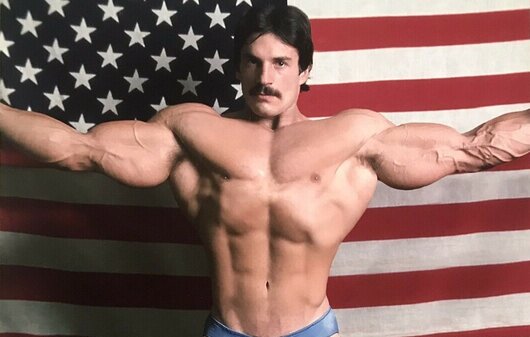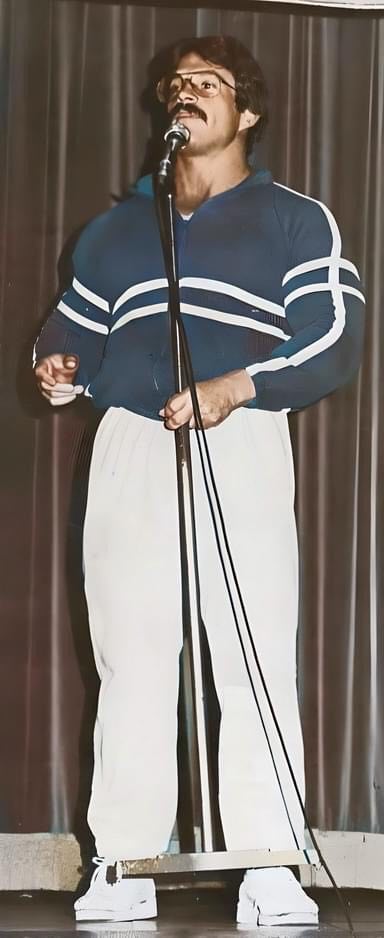Home | Articles | Book | Video | Training
Click Here to Sign Up for Your Free High Intensity Training Magazine Subscription
Mike Mentzer Bodybuilding Seminar
The following article was written by Ray Back around 1978, after Mike Mentzer gave a bodybuilding seminar in Vancouver the evening prior to his winning the IFBB Mr. North America championships (he beat Darcy Beckles and Dave Dupree).
“Mike Mentzer credits his recent success to a decision he made two years ago. He had been training two hours every day, but his progress had stalled; so he increased his workouts to three hours a day. He figured what he needed was more exercise time. He was wrong. He began to lose size. Panic time! Holding down a job, attending pre-med school. and pumping iron for set after set, hour after hour! He was about to forget his Mr. U aspirations. There just weren’t enough hours in the day!
Mike then remembered the Arthur Jones experiment with Casey Viator which condemned the high set system and advocated few sets and maximum effort. It was worth a try. He cut his workouts down to three one and a half hour sessions a week. Bingo! The results started coming again faster than ever! He continued this thrice weekly program until recently when he split his program and now trains four times a week. He insists you must rest the whole body at least three times a week.
Here then, is the three-time-a-week program Mike outlined for trainees with six months experience or more:
a. Thigh extension with: b. Half Squats (or Leg Press)
a. Leg Curls with calf raises
a. Straight Arm Pulldowns on Lat Mach. (or One Dumbbell Pullover) with: b. Pulldowns on Lat Machine or (One Arm Row)
a. Chest Flys with cables or dumbbells with: b. Bench Press (or incline press)
a. Shoulder Shrugs with: b. Upright Row
a. Deltoid Lateral Raises with:
b. Press Behind Neck
a. Press Downs on Lat Machine with:
b. Close Grip Benchpress
a. Scott Bench Curls (or Concentration Curls) with:
b. Barbell Curls.
c. Situps with weightAll exercises, including waist and calves, are done in sets of eight to twelve reps. a. and b. exercises are supersetted for two sets.
c. exercises (Leg Curls, Calves and Waist) are given three sets as they are done individually. To illustrate how to properly superset the a. and b. exercises for a cycle, let’s look at the thigh extension an ‘a’ exercise and the half squats which is the ‘b’ exercise.
In the thigh extension, take a weight you can do seven or eight reps, then with complete concentration on the thigh muscles, do the first rep slowly to avoid injury, and slowly move the weight up and slowly let the weight back down again – fighting the weight up and down (positive and negative resistance) – keep moving the weight until you can’t budge it – not even an inch. Now, reduce the weight by removing ten or twenty pounds, or by doing assisted reps with a partner – grind out four or five reps – making a total of around twelve reps give or take a rep or two. Then immediately, with no rest, start the half squats, repeating the same rep system as in the thigh extension – working to complete failure for the first seven, eight, nine or nine and one-half reps; then three, four, or five more reps with the lightened load. Now you have completed one cycle or superset. Rest one to three minutes and then repeat the two exercises for one more cycle.
Mike says to rest just long enough to catch your breath between sets. He advocates that the whole workout be done as quickly as possible.
The a. exercises are Isolation exercises working mainly the one muscle group. These exercises are done to pre exhaust the muscle prior to doing b. the Compound exercise – giving the other muscles used on the exercise an advantage over the pre-exhausted muscle.
For example, in working the chest, you pre-exhaust the pectorals by doing Fly's then immediately doing the Bench Press, thus giving the triceps muscle of the arm the advantage over the pecs.
Normally, the triceps would “give up” before the pecs had a good workout in the Bench Press. The Bench Press is primarily a triceps exercise but because the pecs are subject to such heavy weight in this position, it is a good chest exercise. The chins or pulldowns are primarily a bicep exercise, but the same thing applies here.
Naturally, working to failure in the Squat or Bench requires a spotter or Safety Racks. The exercises in brackets (..) are substitute exercises to be used to change the program in a month or two or if you are short on equipment.
I put Mike’s program to the test here at the Western Gym. The ones that did it properly made fair gains on it so far (two moths). Most however, said it was too tough, quit, and went back to pumping out high sets. The members who wanted a fast workout found it great, especially for cardiovascular fitness. Usually, they didn’t push hard enough or use heavy enough weights.
Some of my members increased the cycles to three and split the program into two days with four workouts a week – doing chest, back and shoulders on Monday and Thursday; and doing legs and arms on Tuesday and Friday. The calves and waist are worked every workout.
You may find it hard to accept, as I do, that Mike only works his calves and waist three sets of eight to twelve reps three or four times a week. He says to work them the same as any other muscle with heavy weights. It’s a good idea to warm up well with medium light weights before tackling the heavy weights. Keep a record of the weights you are using and increase the weight when you reach twelve reps without assistance or lightening the load. The reason most people fail to progress is because they fail to increase the weights they use. Sure you can pump the muscles up with light weights – but muscles developed using maximum weights stay with you longer.
Mike says he doesn’t use food supplements except “a little potassium when doing a low carb diet before a contest.” Mike puts credence in advice based on scientific university findings in nutrition and exercise – not on gym owners or magazine publishers. (Aw, come on, Mike, some of us went to universities, and we know a lot of enlightened findings have come from laymen.) Anyway, very little has come from the academics yet pertaining to muscle building methods and nutrition.
One effect Mike’s pronouncements have had in the gym is the men are doing less sets but training with more intensity, squeezing out the reps. Finally, I would like to close with some advice Mike gave that I concur with:
“Just because a guy is a Mr. Universe or owns a gym or a muscle mag doesn’t make him an expert on muscle building. You've got to find out what works for you – only you can do that. Read everything, be open minded, experiment once in a while, then report your results, good or bad, to the muscle media.
After all,” says Mike, ” Think of the results Arnold and Robby could have made if they trained properly!!!!!!!!!!”
If you have any questions about Mike Mentzer, Heavy Duty, High Intensity Training, Diet, etc. email us and we'll get back to you with an answer as soon as we can.
Click Here to Sign Up for Your Free High Intensity Training Magazine Subscription
Home | Articles | Book | Video | Training

Mike Mentzer Mr. America and Mr. Universe
